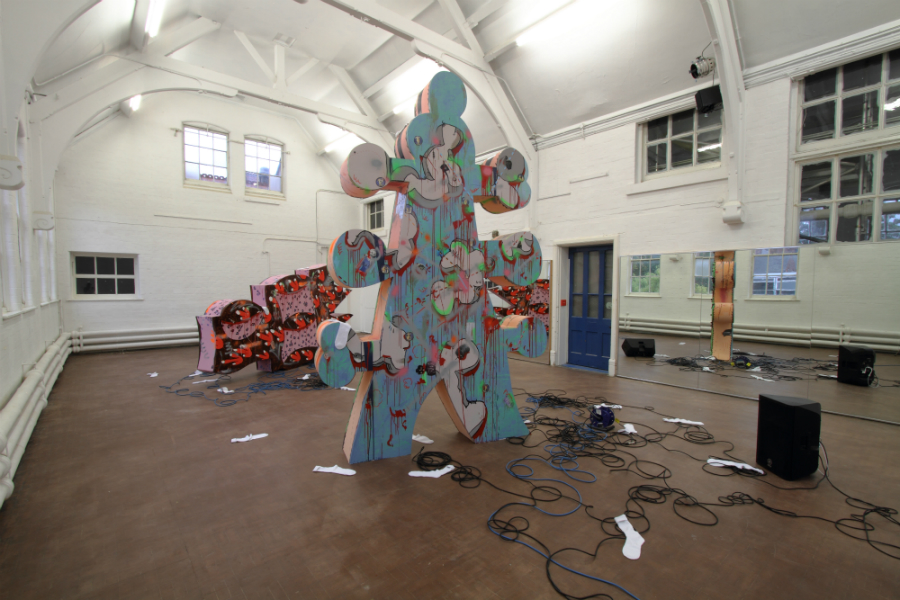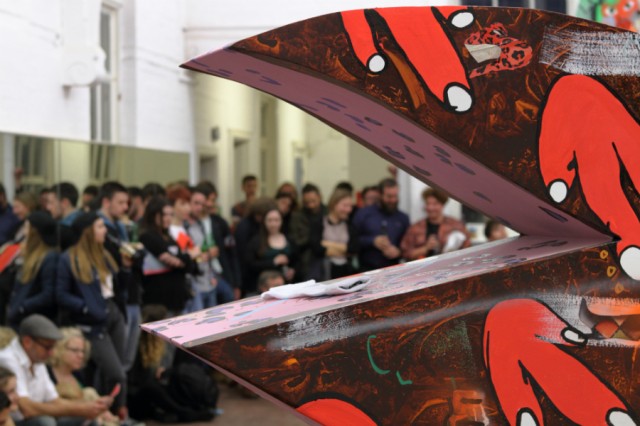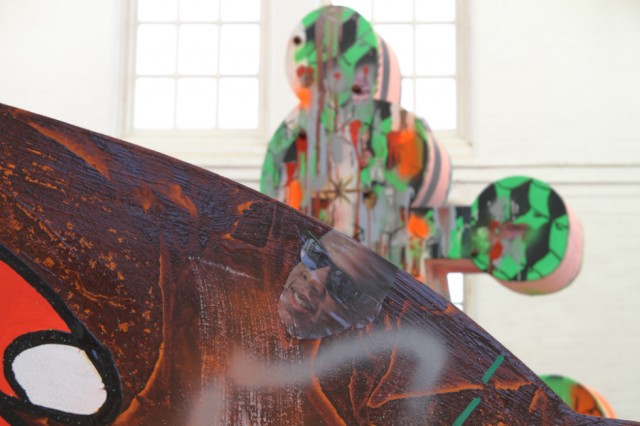The Big Interview: Artist Edwin Burdis

Experimental musician, Raver, Mark Leckey collaborator, and… international supermodel?! Wayne Burrows sits down with artist Edwin Burdis to find out about his past, present and future…
In a short essay on artist Edwin Burdis’s work, written in advance of his residency at Primary, Nottingham, the artist, poet and frequent Burdis collaborator Heather Phillipson notes: “Edwin’s work is a matter of tone – or more accurately, gusto. Everything is thrown into, or at, it.” His is a body of work that cannot be easily defined — film, performance, painting, sculpture, sound and installation, often all at once, and usually informed by an absurdist sense of humour.
Burdis’s previous work includes The Fruit Machine (2013), an operatic allegory and large scale painting about the relationship between humans and fruit, while Back Sack and Crack (2010, featured in the Guardian here) presented a series of around a hundred gleefully unruly A5 sized drawings, half Philip Guston, half Viz comic. One artwork to come out of Burdis’s month-long residency at Primary is UIB (The United Islands of Brittle-leen), set in an imaginary (and waterlogged) future Britain.
We caught up with him in his studio at Primary to discuss his roots in 1990s rave culture, love of science fiction films and the importance of drawing…
Wayne: I gather you started out as a musician?
Edwin: I’m not sure I’d say I was a musician, exactly, but music was one of the things I did. The first time I had a plan and set about executing it, getting a job to make money so I could do something, it was to buy hardware to make music. So at the time, for me, that meant buying an AKAI Sampler and an 8-track DAT machine.
This would have been the early ’90s?
Yes, early ’90s. I’d always done drawings but that was the first time I’d really got involved with a social group that was about making things happen, putting on nights, making white labels and records. So I wasn’t a musician, I was basically a raver.
Your interest was in electronic music, dance music?
Yeah, as in it was sampled music, so I’d sample records, CDs, other people’s stuff, but the samples themselves weren’t necessarily electronic. It was all cut and paste, with a keyboard to make bass-lines. I wasn’t interested in playing music or being in bands then, but I wanted to make records. At the time my inspirations were people like A Guy Called Gerald or Goldie, especially Goldie, because he’d been a graffiti artist and got into rave. The big things for me at that point were rave and jungle and drum’n’bass. I got really into it all and for a few years everything I did was shaped by that scene. For one very intense year, jungle was everything. All I did was record jungle tracks, go to jungle nights, pretty much nothing else for that whole year.
Where was this?
This was Coventry. It was basically the whole M1 rave thing. But, yeah, that was the first time I’d had a plan that was about doing something creative, something that wasn’t just about me being at home drawing or painting on my own. Looking back, it was probably also about stepping outside what’s traditionally seen as the path you’d normally take to become an artist.

Were you still drawing within that scene?
Yeah, kind of — I was drawing the whole time, as I always have, but I only dabbled a little bit in things on the scene like graffiti. The thing I liked about graffiti was the act of doing it, the colour and forms of it, the desire to make a mark – I could really understand all that. What I didn’t understand was the way that the scene, at the time I was finding it, had already become quite rarefied and full of rules. It had become a kind of clique, which seemed to be the opposite of what graffiti had started as – something all about breaking out, making a mark on the world in a rebellious way.
What led you to leave that scene?
What changed was that, hard as it might be to believe now, I was talent-spotted by a modelling agency, Models One, and they took me on, which meant I ended up travelling a lot, doing catwalk shows and photo-shoots. Which didn’t make me much money, but because I’d draw while I was travelling or hanging around, and fashion people saw the drawings, it led me to doing fashion illustration. I lived in New York doing that at the point when the internet was just starting to become big and everyone was first making websites.
The funniest was doing all the branding and illustration for a female-run sex-toy company, which they wanted to give a fashion look. It was all very ’90s stuff, you probably know the style I’m talking about – hand drawn images on block colours. But drawing has always been important, to the point where I can really feel it when I’ve not been drawing for a while. The shapes and forms of the sentinel sculptures I’ve made at Primary came from old drawings.
Was your decision to move from music into art planned the way that earlier move into music had been?
There have definitely been moments where I’ve made conscious decisions to leave something behind and move on to something else, and the decision to call myself an artist and say ‘this is what I do’ was definitely one of those. I left a band that I was heavily involved with, and I’d really enjoyed it, but the guys I was working with were all a lot younger than me and passionate about it – and it was something I couldn’t, given the lifestyle, do anymore. I had to stop. That meant financially I was, basically, poor — which was when I moved in with my mother, who gave me the space and time to make work. I’d also been pursuing things for the wrong reasons, so for a long time I was after financial gain, wanting to make lots of money, which was never going to happen because the band I was in wasn’t making that kind of music.
Before that, you’d been working with people like Mark Leckey?
Yes, in my mind there were two stages in that decision to become an artist. The first was doing things with Mark and through him meeting lots of other artists who were working in a part of the art world that I hadn’t known existed ’til then. That stopped partly because everything I was seeing was so amazing, so hardcore, that I began to lose confidence in my own abilities, which is when I went back to music. But being with the band made it clear to me what an amazing opportunity I’d had. I’d met these people who were doing amazing things and knowing those people existed was brilliant. But I also got quite fearful about it and it all got a bit confusing. I started to get what I can only describe as delusions of grandeur, but at a point where I hadn’t put the hours in, hadn’t made the work yet. I’d had a place in that world but it was still sort of sitting on the backs of other people.
Maybe it also wasn’t such a big leap from music, given that the influence of sampling is there in the work you’ve made more recently?
There’s a level of the work which is totally rooted in drawing, and comes from the way the act of drawing brings things out from the mind. But there is another level which is about taking things I’ve seen in other places and thinking, yeah, I’ll take this from here and that from there, so probably subconsciously there is that layer of sampling. Sound is still a part of everything I do, as well, but I don’t see it as separate from my sculptures, paintings, video and the rest. I see it all as one big mush.
You’ve used the word ‘opera’ to describe this new commission, UIB, at Primary.
Yeah, opera is one of the words I’ve found useful to describe what I want to do that a lot of people can understand. In a traditional sense, an opera is a single work made of lots of different elements – music, sets, costumes, words – but it’s also a bit absurd, and you have to be very serious about what you’re doing to make the stuff, even if the end result doesn’t feel all that serious to watch or experience.
Has the experience of being at Primary changed your original proposals? I notice there’s a part-built sculpture outside that’s been edited out.
Yeah, there is, and I might even take away another one, one of the more finished ones, that’s something I’ve been playing with. It might even end up with just one structure in the space, I don’t know yet. It’s been really interesting because this is the first time I’ve used a period of making in a particular space to begin to really play, to start understanding what a residency is, rather than just using it as a way of making a piece of work I’d already planned out in advance.
When you first arrived you showed and talked about some excerpts from your film Light Green and Dark Grey. Is that initial suggestion of a continuing exploration of ‘Englishness’ still part of the story of UIB?
I think a lot of what I do is about England, just because that’s where I’m from. It’s not about understanding, more about navigating and trying to exist in it. I’ve lived quite a privileged life and part of that’s been about seeing other places in the world. Coming back I do think there’s something quite special about England – by which I mean Britain, but England as my own part of it. I mean, I also worry a lot about England, while still being proud of it – I’m not proud of what some individuals or groups from England have done in the past or are doing now, or of what the English are doing to themselves, but I am proud of the culture, the music and art, which is brilliant, deep and rich. I hope that what I do is part of that.

There are references to some of those things in the sculptures, so one has a finish that reminds me of Chris Ofili’s early paintings, another has designs that look like 1980s UK underground comics motifs.
Yeah, there are the stuck-on things that look a bit like his elephant dung but are actually conkers. I’ve been aware of that and if I’m honest I’m not sure how I feel about it. I’m glad you can see those things because even though it’s not conscious it’s the stuff I grew up with, that’s in my head, so it all gets into the work. I was doing that painting and even as I was doing it I was thinking, ‘bloody hell, this is going to look like something from Chris Ofili territory’, but then I thought – well, bollocks to it, it’s obviously influenced me somewhere, it’s stuff that’s been important to me in some way so I’m going to leave it alone. It probably belongs there.
Are there particular sources you’ve drawn on for the sound?
My original idea was that it was going to be a sort of story, but now I’m getting to hear the sound in the space I’m starting to take out the actual words because sonically it’s not working. But there will be two different mixes, one for the room, which is a very large space, and a different mix for the video which will be online, and that one will probably have more of the story. The video is a kind of documentary.
Film shot over the last few weeks in Nottingham?
Yeah, all shot here and around, but not just about the work I’ve been making, more looking at people and life and the rest of it. As for the sound sources, originally I had a whole set up I was going to work with, but while I’ve been here a lot of that’s gone and it’s now mostly new things I’ve made. I went to the studio my old bandmates have because they’ve got a Moog there, so I’ve used a lot of Moog on this, to get that kind of psychedelic thing going on — like a 1970s sci-fi film, basically.
You described the sculptures as sentinels, and I thought of the WW2 concrete bunkers that turn up around the UK coastline, derelict and covered in graffiti.
Yeah, I hope they’re slightly mysterious, and that’s definitely the sort of thing I want those structures to evoke – things from the future that are also from the past. Things whose purpose has been lost but still seem to embody something. But for me the ’70s sci-fi thing isn’t about a love of B-movies, though I do like a lot of that stuff; it’s more about the fact that those kinds of films have these grandiose ideas and ambitions but try to realise them on an a shoestring. Another example might be something like Westerns, where people know they can make a film using a few basic elements, and one of those is the fantastic scenery in whatever country they happen to be filming in. Landscape becomes this massive character in those films and I prefer that approach of just using what’s there.
There’s something in the way Stanley Kubrick’s A Clockwork Orange uses the flats and subways at Thamesmead that grounds the film.
Yeah, A Clockwork Orange is a really good example of what I’m getting at, exactly that use of real places and locations. It goes back to the Italian films made just after the war, where there wasn’t any money so they’d just go outside and shoot thrillers or crime films, or other weird stuff, in the ruins. There’s a different kind of energy in that way of doing things.
When sculptor/installation artist Jonathan Baldock was at Primary, in the same space you’re working in, he said it reminded him of Dario Argento’s Suspiria.
That’s funny because I had a realisation today that I wished I’d made a film here, shot in and around the old school. I mean, I couldn’t have done it in a month – or maybe I could have done it, but it would’ve been crap – but it’s such a great location. When I first arrived I went to Asda to get a load of food and they had a table in the shop selling second-hand books for 20p. One of them was The Shining, which I bought and started reading. I had to stop reading it really quickly, because being here in the building at midnight and reading that book meant I was almost shitting myself, having to turn on all the lights just to get myself out of the front door. Primary’s building is very cinematic, all the corridors and rooms, the playground outside with no kids, the slightly scary Victorian architecture. You could easily make a low budget horror film here.
Do you feel that atmosphere has shaped the work you’ve made in other ways?
Not too much. I think what I’ve made is quite foreign to the environment it’s been made in. Maybe that’s why I wish I’d had more time here, because if I’d been here longer more of that atmosphere would have got into the work. But I suppose there’s also been an idea that the work I was making was meant to be from another time, from the future, so it’s probably more appropriate that it feels a bit foreign or alien to the space it’s occupying. But in a way the whole process has been about me trying to navigate things and make something out of my own life. In the end I don’t really know what I’m doing, and that’s been kind of the point.
Wayne Burrows
Edwin Burdis (b. Newcastle, 1974) has significantly contributed to the London art scene for over a decade, collaborating with artists, writers and musicians including Mark Leckey, Steven Claydon, Bonnie Camplin, Kieron Livingstone and Heather Phillipson. His work has been present internationally in exhibitions and performances at amongst others: Wysing Arts Centre, Cambridge, UK; BROADWAY 1602, New York, USA; Hayward Gallery Project Space, London, UK; ICA, London, UK; Victoria and Albert Museum, London, UK; and Skanes Kunstforening, Malmo, Sweden.
Edwin Burdis: UIB, at Primary, Nottingham — exhibition open to the public until 1 November 2014, free entry. Catch the exhibition’s lunchtime tour, led by Patrick Farmer, at 1pm on 17 October 2014
Images: Edwin Burdis, UIB (2014); photography courtesy James E Smith





